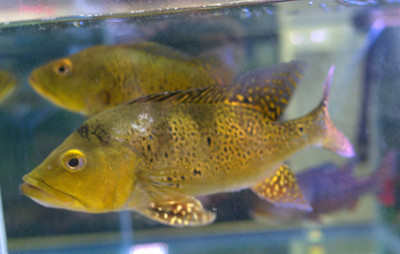Peacock Bass in the Aquarium: A Guide to Keeping These Magnificent Predators
Posted by Max Gandara on on 21st May 2024
Peacock Bass in the Aquarium: A Guide to Keeping These Magnificent Predators
Peacock Bass are among the most striking and formidable freshwater fish that can be kept in an aquarium. Known for their vibrant colors, impressive size, and predatory nature, these fish are a favorite among advanced aquarists. In this blog, we'll explore everything you need to know about caring for Peacock Bass in a home aquarium, from their natural habitat and care requirements to their diet and compatibility with other tank mates.
Introduction to Peacock Bass
Peacock Bass, scientifically known as Cichla species, are native to the river basins of South America, particularly the Amazon and Orinoco rivers. Despite their common name, they are not true bass but rather belong to the cichlid family. They are known for their beautiful, iridescent colors and distinctive markings, including the characteristic "eyespot" near the tail. Some of the popular species include the Butterfly Peacock Bass (Cichla ocellaris), the Royal Peacock Bass (Cichla temensis), and the Orinoco Peacock Bass (Cichla orinocensis).
Natural Habitat
In the wild, Peacock Bass inhabit slow-moving rivers, lakes, and floodplain areas with plenty of
cover from submerged vegetation, fallen trees, and rocky outcrops. These environments provide ample hunting grounds for these predatory fish, which primarily feed on smaller fish and invertebrates. Understanding their natural habitat is key to replicating suitable conditions in a home aquarium.
Aquarium Setup
Tank Size
Given their potential size—Peacock Bass can grow up to 24 inches or more in captivity—a very large tank is essential. A minimum tank size of 200 gallons is recommended for a single adult, with larger tanks required if you plan to keep multiple specimens or other large fish.
Water Parameters
- Temperature: 76-86°F (24-30°C)
- pH Level: 6.5-7.5
- Hardness: 2-12 dGH
Maintaining stable water conditions is crucial for the health and well-being of Peacock Bass. They are relatively hardy but thrive best in warm, slightly acidic to neutral water.
Substrate and Decor
A sandy or fine gravel substrate is ideal to mimic their natural environment. Include large pieces of driftwood, rocks, and sturdy plants to provide hiding spots and reduce stress. Peacock Bass are powerful fish and can be quite destructive, so ensure that decorations are secure and won't topple.
Lighting
Moderate lighting is sufficient for Peacock Bass. They do not have specific lighting requirements, but proper lighting will help showcase their vibrant colors and natural behavior.
Diet and Feeding
Peacock Bass are voracious predators with a diet primarily consisting of live prey. In captivity, a varied diet is essential to ensure their health and proper growth. Suitable foods include:
- Live or frozen fish: Feeder fish such as goldfish or guppies (use with caution to prevent disease).
- Insects: Crickets and mealworms.
- Pellets: High-quality carnivore pellets or cichlid sticks.
- Frozen foods: Bloodworms, shrimp, and krill.
Feed them once or twice a day, offering only as much food as
they can consume in a few minutes to prevent overfeeding and maintain water quality. It’s important to ensure a balanced diet to meet their nutritional needs.
Behavior and Tank Mates
Peacock Bass are known for their aggressive and territorial behavior, particularly as they grow larger. They can coexist with other large, robust fish, but careful consideration is needed to ensure compatibility.
Compatible Tank Mates
- Large Cichlids: Such as Oscars, Jaguar Cichlids, and Red Devils.
- Catfish: Larger species like Plecos and Redtail Catfish.
- Other robust fish: Arowanas, large Silver Dollars, and Pacus.
Avoid keeping Peacock Bass with smaller, more delicate fish, as they will likely become prey. Providing plenty of hiding spots and territories can help reduce aggression.
Breeding
Breeding Peacock Bass in captivity can be challenging but is possible with the right conditions. They are substrate spawners and prefer to lay their eggs on flat surfaces. Here are some tips for breeding:
- Provide a spacious tank: At least 300 gallons to accommodate a breeding pair.
- Maintain optimal water conditions: Slightly warmer temperatures around 82-86°F can stimulate spawning.
- Create suitable breeding sites: Flat rocks or large pieces of driftwood where the female can lay her eggs.
Once the eggs are laid, both parents will guard the nest aggressively. The fry can be fed with finely crushed flake food or baby brine shrimp once they become free-swimming.
Health and Disease
Peacock Bass are generally hardy but can be susceptible to common freshwater diseases if water quality is not maintained. Watch for signs of illness such as:
- Ich: White spots on the body and fins.
- Fin rot: Fraying or discoloration of the fins.
- Internal parasites: Weight loss and reduced activity.
Preventive measures include maintaining pristine water conditions, providing a balanced diet, and observing any changes in behavior or appearance. Quarantine new fish before adding them to the main tank to avoid introducing diseases.
Conclusion
Peacock Bass are a stunning and impressive addition to any large aquarium. Their vibrant colors, predatory nature, and engaging behavior make them a fascinating species for advanced aquarists. By providing the right environment, diet, and care, you can enjoy the beauty and excitement of these magnificent fish for many years. Whether you’re an experienced hobbyist looking for a new challenge or simply captivated by their allure, Peacock Bass offer an unforgettable and rewarding experience.

